April
13, 1969

Directed
by Marc Breaux ~ Executive
Producer George Schlatter ~ Written
by Chris Bearde and Coslough Johnson

Dinah
Shore
(Herself, Host / Various Characters) was
born Fannye Rose Shore in 1916. She was a singer, actress, and
television personality, and the top-charting female vocalist of the
1940s. She rose to prominence as a recording artist during the Big
Band era, but achieved even greater success a decade later, in
television, mainly as hostess of a series of variety programs. Her
first recordings were with Desi Arnaz’s mentor, bandleader Xavier
Cugat, and she later changed her named to Dinah after her success
with the song of the same name. She was famous for blowing a kiss to
her audiences (“Mwah!”) at the end of each show.

Shore appeared
as herself on a 1971 episode of “Here’s Lucy” (S4;E7). Shore and
Ball appeared together on many television talk shows, specials and
award shows together. Her passions were golf, cooking, and painting.
Shore died in 1994.
Lucille
Ball (Herself
/ Various Characters) was born on August 6, 1911 in Jamestown, New
York. She began her screen career in 1933 and was known in Hollywood
as ‘Queen of the B’s’ due to her many appearances in ‘B’
movies. With Richard Denning, she starred in a radio program titled
“My Favorite Husband” which eventually led to the creation of “I
Love Lucy,” a television situation comedy in which she co-starred
with her real-life husband, Latin bandleader Desi Arnaz. The program
was phenomenally successful, allowing the couple to purchase what was
once RKO Studios, re-naming it Desilu. When the show ended in 1960
(in an hour-long format known as “The Lucy-Desi Comedy Hour”) so
did Lucy and Desi’s marriage. In 1962, hoping to keep Desilu
financially solvent, Lucy returned to the sitcom format with “The
Lucy Show,” which lasted six seasons. She followed that with a
similar sitcom “Here’s Lucy” co-starring with her real-life
children, Lucie and Desi Jr., as well as Gale Gordon, who had joined
the cast of “The Lucy Show” during season two. Before her death
in 1989, Lucy made one more attempt at a sitcom with “Life With
Lucy,” also with Gordon, which was not a success and was canceled
after just 13 episodes.
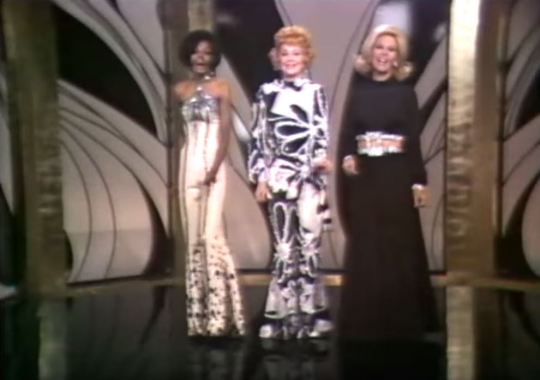
Diana
Ross (Herself
/ Various Characters) makes
her first television appearance as a solo act after many years of
headlining with The Supremes. The
group released a record-setting twelve number-one hit singles on the
Billboard Hot
100. As
an actress, she starred in Lady
Sings The Blues (1971),
Mahogany
(1975), and The
Wiz (1978).
Ross
is credited by the announcer as Dinah’s “Extra Added Attraction
Guest”.
Dick
Martin (Himself
/ Various Characters, below right) is
probably best remembered as the co-host of “Rowan & Martin’s
Laugh-In” from 1967 to 1973. He was born Thomas Richard Martin on
January 30, 1922, in Battle Creek, Michigan. As a teenager he lost a
lung to tuberculosis and used bottled oxygen for the rest of his
life. Martin was a writer for the popular radio show “Duffy’s
Tavern” before teaming up with Dan Rowan in the 1950s. They played
nightclubs and Las Vegas before Martin was cast as Lucy Carmichael’s
boyfriend Harry Conners on “The Lucy Show,” his ‘acting’
debut. He was married three times and died in 2008 of respiratory
failure.
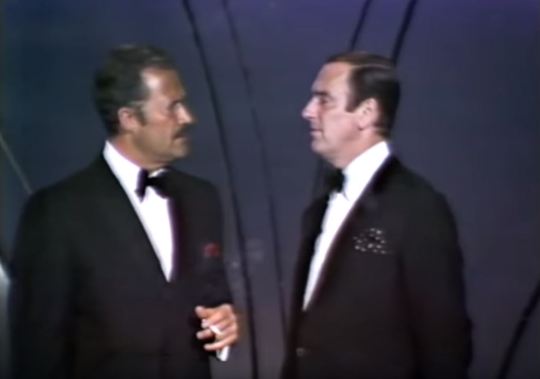
Dan
Rowan (Himself
/ Various Characters, above left)
is
best known as the co-host of “Rowan and Martin’s Laugh-In”
which earned him a 1972 Emmy Award. In 1966 he had appeared with
Lucille Ball on “The Dean Martin Show.” Rowan made two
appearances on “The Lucy Show” in 1966 and 1967. He died in 1987
at age 65.
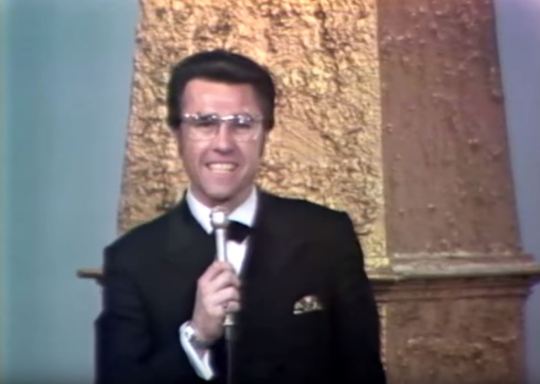
Gary
Owens
(Announcer / Emcee, uncredited) was also, not surprisingly, the
announcer for “Laugh-In.”
Lorne
Greene
(Himself, uncredited) appears in his costume from “Bonanza” in a
couple of quick comic cut-aways.
The
Smothers Brothers
(Themselves, uncredited) had a variety show that was opposite this
special on CBS. They were generally up against “Bonanza.”
Tom
and Dick Smothers only appeared at the very end of the final credits, in
a one shot gag. The gag was not included in the rebroadcast.
Greg
Morris (Nightclub
Patron, uncredited) was appearing in the Desilu spy thriller
“Mission: Impossible” at the time. He does not have any dialogue.
Victor
Buono
(Corrupt Rival Gang Leader, uncredited) played “Batman” villain
King Tut from 1967 to 1968. A month before this cameo, he had
appeared on an episode of “Here’s Lucy” (S1;E21). He does not
have any dialogue.
Jay Meyer (uncredited) was a singer and actor who performed with such stars as Ray Conniff, Jack Benny, Danny Kaye, and Tennessee Ernie Ford, just to name a few. Jay also worked for 13 years at Disneyland in the Golden Horseshoe Revue and became one of the singing ghosts busts in the Haunted Mansion. His career continued until his mid-seventies. He died in 2009.
Carole
Cook
(Lucy’s Singing Voice, uncredited) played
Thelma Green on “The Lucy Show” as well as a host of other
characters. She was a protege of Lucille Ball’s during the Desilu
Playhouse years. Although born as Mildred Cook, Ball suggested she
take the name Carole, in honor of Lucy’s great friend, Carole
Lombard. Cook appeared in five episodes of “Here’s Lucy” as
various characters and sometimes was a ghost singer for Lucille Ball.
About
the title: Hip v Hep ~ ‘Hip’
is
a slang
term for
fashionably current or to have an attitude in opposition to the
unfree (or un-cool) world. It entered common parlance after World War
II. In the 1940s the word ‘hep’ became used interchangeably (not
without controversy) with ‘hip,’ especially by Jazz musicians,
although ‘hip’ eventually proved the more time-tested of the two
terms. “Like Hep” the TV special seems to suggest that the term
‘hep’ is coming back, which proved not to be true. You hep?

In
the fall of 1969, George Schlatter also had Diana Ross as a guest on
two episodes of “Rowan & Martin’s Laugh-In.” The NBC smash
hit’s second half hour competed with “Here’s Lucy” on CBS. Both
Dan Rowan and Dick Martin had appeared many times on “The Lucy
Show” before their big success with “Laugh-In.” Interestingly,
“Here’s Lucy” frequently incorporated catch phrases from
“Laugh-In” like “Here
Come the Judge”
and “Sock
It To Me” in
order to stay contemporary. “Laugh-In” regulars Ruth Buzzi and
Arte Johnson guest starred on “Here’s Lucy.”

In
one of J. Randy Taraborrelli’s books about Diana Ross, he wrote that
Lucy and Dinah “gave
Diana hell”,
and took advantage of her inexperience with comedy. Other accounts, however, relate that Ross’s experience
with Lucy and Dinah was a good one. The “gave
her hell”
line just referred to the fact that hey worked her hard, but she
wasn’t intimidated because they were all working hard to make it
right. In the planning stages they all met at Lucy’s house to discuss
the special and everyone was very cordial. Diana and Lucy had a
friendly relationship after the special as well with Lucy praising
Ross’s performance in Lady
Sings The Blues.

In
a Diana Ross book, she’s quoted as saying Lucy and Dinah pretty much
ignored her. She may have been over-sensitive or it may be that Lucy
and Dinah found it hard to find common ground for chit-chat, their
backgrounds and ages being so different. When this special was shot,
Lucy was 57 (going on 58) Dinah was somewhere between 52 and 55
(depending on your source), while Diana was just 25.

Later
in 1969, Diana Ross appeared on television with The Supremes in
“G.I.T. on Broadway,” also produced by George
Schlatter.
That special also contained the song “Let The Sunshine In” from
the Broadway musical Hair.

Coincidentally,
NBC’s lead-in for “Like Hep” was the final episode of the Desi
Arnaz series “The Mother-In-Law.” That night’s episode was
directed by Elliot Lewis and featured his wife, Mary Jane Croft (Mary
Jane on “Here’s Lucy”). It was written by Lucy’s original writers Bob Carroll Jr. and Madelyn Davis.

More
coincidental, “Just Hep” was programmed opposite “The Smothers
Brothers” on CBS which that night guest starred Dan Rowan.
Following “The Smothers Brothers” was the Desilu produced series
“Mission: Impossible.”
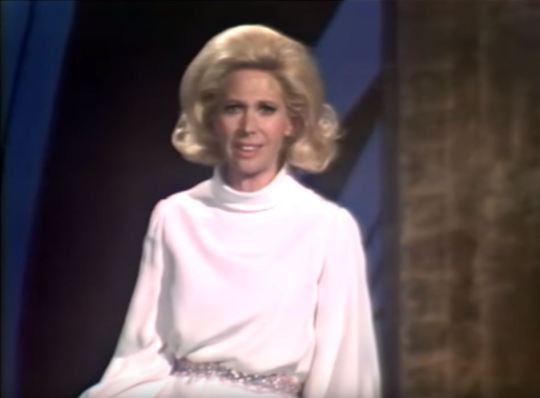
Dinah
makes her first entrance in an elegant setting singing “For
Once In My Life”
by
Ron
Miller
and
Orlando Murden in 1966 and popularized by Stevie Wonder. The song
was also recorded by Diana Ross. Dinah stops herself (literally,
thanks to special effects) and says that while “she” is singing
songs like that, the rest of us will be doing something that’s more
“like hep.”
After the opening credits, she finishes the song.
After
the break, Dinah sings “Both
Sides, Now” by
Joni Mitchell, popularized by Judy Collins in late 1968.
After the song is over, Dinah bows and is instantly (thanks again to
technology) in a new outfit. Lucy bounds out to join her.
Dinah:
“It’s
not easy to change clothes that fast on television thanks to all the
new restrictions on sex and violence. Senator Pastore – eat your
heart out!”

John
O. Pastore
is probably best remembered as the senator who was involved in
quizzing Fred Rodgers about the value of Public Television when it
was proposed that their Federal funding be raised by 20 million dollars. In
the end, the generally grouchy Pastore was won over by Mr. Rogers and
funding was increased to 22 million.
Dinah
explains to Lucy that the term ‘hip’ has reverted to ‘hep’ again.
Which launches the song “Like
Hep”
written by Billie Barnes and W. Earl Brown especially for this
special. Diana Ross (in her first appearance) struts in for the
second chorus. Just as in “Laugh-In,” the song is occasionally
interrupted for a few quick comic exchanges about being ‘hep.’ Some of
the names mentioned in the fast-paced song include:
- Terence
Stamp
– English actor famous for the films Billy Budd (1962, Oscar
nominee) and Far From the Madding Crowd (1966). - Betty
Grable
– American starlet famous for her shapely legs who starred in three
films with Lucille Ball in 1935 and guest-starred with her husband
Harry James on a 1958 “Lucy-Desi Comedy Hour.” - “Sock
it To Me” / “Bet Your Bippy”
– Catch-phrases popularized by “Laugh-In” that entered common
usage. - Andy
Warhol – pop artist and counter-culture celebrity who also produced films
and ran the famous Factory nightclub.
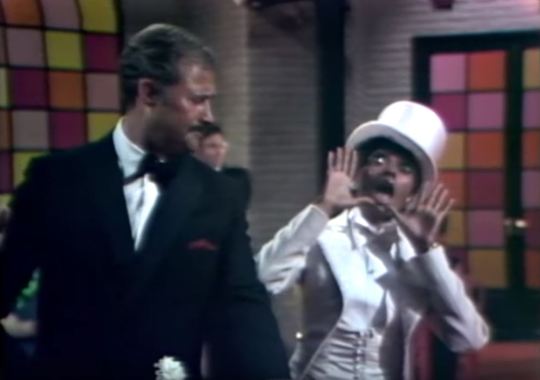
Dinah
introduces “The
Story of the Singing Detective,” which
opens in a nightclub located “in
the outskirts of beautiful lower New Jersey.”
Ross is singing a peppy “Baby
Love”
with four back-up dancers. Greg Morris (“Mission: Impossible”) is
sitting at a table with Dick Martin who constantly (and inexplicably)
wields a screwdriver. Dan Rowan is the “Boss” and Lucy is Joyce,
his “Moll.” Diana asks the Boss about her performance.
Boss:
“You
do a great Minnie Pearl, but how’s your Judy Garland?”
Diana:
(singing) “Somewheeeeeeeeere…”
Boss:
“Work
on it.”
Ross is attempting the song “Somewhere Over the Rainbow”, sung by Garland as Dorothy in the 1939 film The Wizard of Oz. Little did she know then that she would also play Dorothy in the 1978 film adaptation, The Wiz.
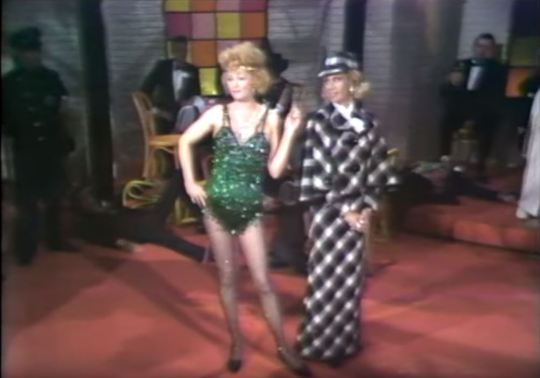
Joyce
takes the floor to sing a few bars of “Big
Spender”
written by
Cy
Coleman
and
Dorothy
Fields
for
the 1966 stage musical
Sweet
Charity.
The film version starring Shirley MacLaine was released two weeks
before this special first aired. Lucy’s belted vocals knock the
corrupt rival gang leaders dead – literally. [Note: This is likely not Lucille Ball’s voice, but that of her frequent ghost-singer,
Carole Cook.] Enter the Singing Detective played by Dinah looking like Sherlock Holmes by way of Las Vegas. The Singing Detective also has a ‘killer
voice’ and with a blast of “From
This Moment On”
(by Cole Porter) everyone in the nightclub (including Diana) drops
over dead!
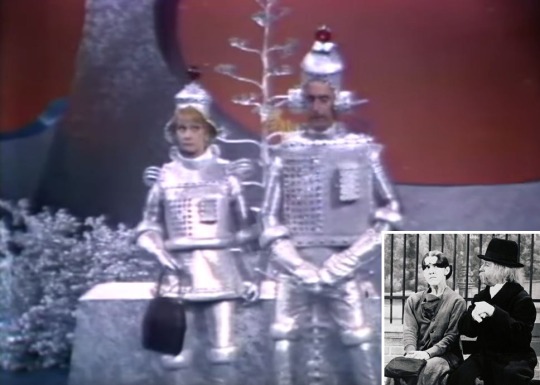
During a bit of brief banter between Lucy and Dick Martin he says he watches “Here’s
Lucy.” Dan Rowan introduces a ‘space age’ song: “The
Age of Aquarius”
from the musical Hair
sung by Diana Ross. The song pauses for Lucy and Dick to play robots who speak an unintelligible language. The robot
sketch slowly morphs into a parody of “Laugh-In’s” popular park
bench skit starring Ruth Buzzi as handbag-wielding Gladys Ormphby and Arte
Johnson as the muttering dirty old man Tyrone F. Horneigh. Lucille Ball did another version of the sketch in 1971′s “The Glen Campbell Goodtime Hour” with Arte Johnson himself.

This
goes directly into Diana [wearing an outfit that only Cher would envy]
singing “Don’t
Ya Hear Me Calling To Ya?”
popularized by the Fifth Dimension and appearing on their 1969 album “The Age of Aquarius”.
It was also the ‘B’ side of the single. The song goes back to Diana
singing “The
Age of Aquarius / Let the Sunshine In.”
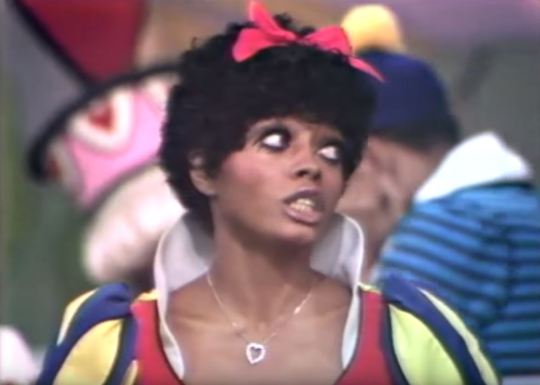
After
”station identification” [remember that?] the background music plays “When
You Wish Upon A Star”
and Dinah introduces “The
Fairy Godmother’s Revenge,”
a fairy tale parody set in Goosetown, a village populated by various storybook
characters. Diana plays Snow White [!], who is worried about the seven dwarfs,
who have gone on strike at the gold mine.
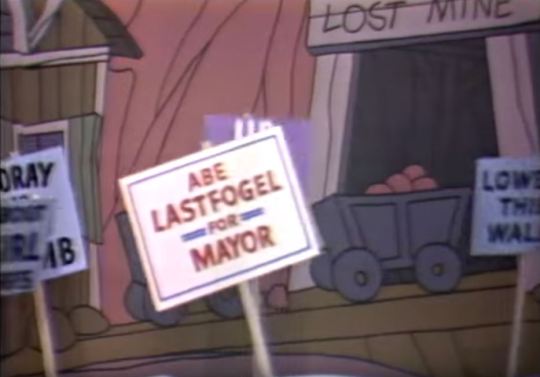
The dwarfs’ picket line is
behind a wall so only their protest signs can be seen. One of the
signs says “Abe Lastfogel for Mayor.” Abe Lastfogel was the
long-time president and agent of the William Morris Talent Agency.
When he died in 1984 he had worked for the agency for 72 years.
Unsurprisingly, he was Dinah Shore’s agent.
Other
picket signs say:
- “Shorter Hours, Smaller Work Days”
- “Mickey
Rooney for President” - “Raise the Floors”
- “Lower the
Ceilings” - “Movie Shorts for Lunch”
- “Rich Little is Nice”
- “More Short Term Loans”
- “We Love Teeny Boppers”
- “Hooray for Tom Thumb”
- “Up With Tiny Tim”
- “How About Some Girl Dwarfs”
- “Cheers for Jockey Shorts.”

Dick
Martin plays Little Boy Blue using a New Orleans drawl and Dan Rowan is
a rhyming Little Tommy Tucker. For help with the strike, Snow White
calls upon her Fairy Godmother (Lucy), and she magically appears.
Lucy is wearing a pink Glinda-like dress and chomping on a cigar. She
is a grouchy Fairy Godmother, annoyed about being woken from her five
decade trance.
Fairy
Godmother: (to
Little Boy Blue): “Are
those your real clothes or are you just trying to stay out of the
Army?”
“Like
Hep” aired at the height of the Vietnam War and the attendant peace
movement. To avoid the draft, some men would claim psychological
exemption due to homosexual or transsexual behavior. This idea was
mined for comedy through the character Klinger (Jamie Farr) on TV’s
“M*A*S*H” (1972).
Little
Boy Blue (about
the Fairy Godmother): “I
hear she’s been bugged ever since her twin sister did the stunts in
‘Mary Poppins’.”
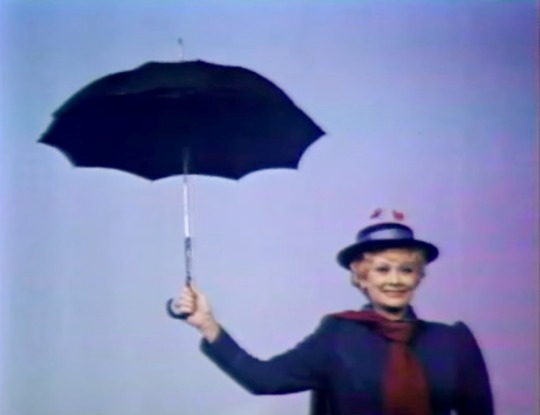
That’s
Lucy’s cue to go flying overhead (on very visible wires) as Mary Poppins, singing “A
Spoonful of Sugar.”
Once again, Lucy’s singing voice is probably dubbed by Carole Cook.
Dinah comes in and out as several fairy tale damsels: Little Miss Muffet looking for her tuffet; a girl
named Candy looking for a guru; and Little Bo-Peep looking for her
sheep.
Trying
to make the mean Fairy Godmother smile, Bo-Peep and Snow White sing a
song that mashes up all the fairy tales into one and (at the end) even
includes suggestions of Dracula!
Bo-Peep and Snow White:
“That’s our fairy
bippity-boppity-zippidy-bang-bang-chitty-chitty-doo-dah tale!”

As
Mary Poppins (“the
Fairy Godmother’s crazy stuntman sister”)
flies in to save the day, she collides mid-air with Ye Olde Flying
Nun. The TV series “The Flying Nun” starring Sally Field ran from
1966 to 1970 on ABC. The mean Fairy Godmother finally gives in to
the dwarfs’ demands. [General rejoicing.]
Dinah:
“They
lived happily ever after. The dwarfs grew up and became Jim Arness.
The Fairy Godmother turned into an aardvark and ate Philadelphia. And
as you well know, the giant chicken and the giant rabbit ran off to
Athens together and became Spiro and Agnew.”
Jim
(James) Arness played
Marshal
Matt Dillon from
1955 to 1975 on the TV series “Gunsmoke.” Greek-American Spiro
Agnew
was the recently elected Vice-President of the United States under
Richard Nixon.

In a break from the silliness, Dinah
sings “The
Windmills of Your Mind” by
Michel
Legrand and
Alan
and Marilyn Bergman for the
1968 film The
Thomas Crown Affair wining
the Academy Award for Best Song.
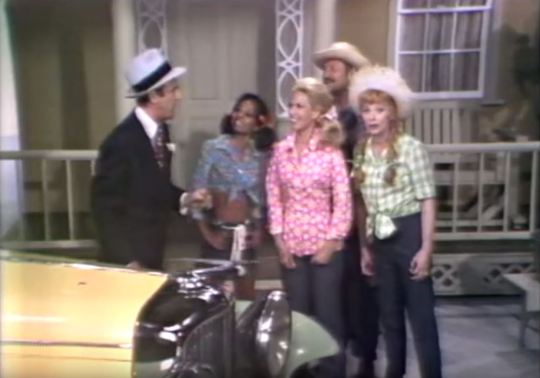
A
sketch about the country bumpkin Whitebread
Family
starts with a down-home song from Mandy (Lucy), Randy (Dinah) and
Sandy (Diana). A rich stranger rolls up (in a Rolls), and offers to
put them in “the show business.”
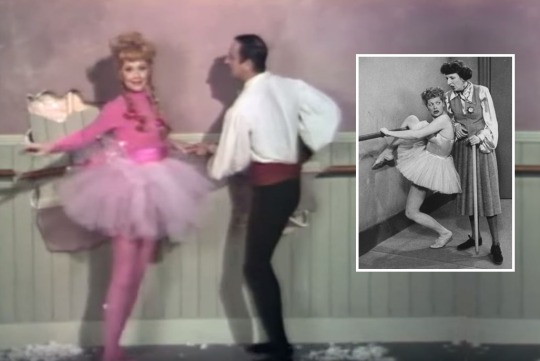
In a montage sequence, the three
girls each take ballet lessons. The sight of Lucy at the barre is
immediately reminiscent of “The Ballet” (ILL S1;E19), where Lucy
Ricardo was put through her paces by Madam Lamond (Mary Wickes). In
the next montage, the girls take music lessons. All the while, the
trio’s brother (Dan Rowan) is trying out his frog impressions while
holding a plate of apple pie with an American flag stuck in it. [No.
Really.]

Flash
forward to “a
little more than four months later,” the Whitebreads are in Las Vegas doing their act, which begins with
“There’s
No Business Like Show Business”
by Irving Berlin. On a huge Ziegfeld-like staircase (the same from
earlier in the show), flanked by glittering showgirls and boys, the
now formally dressed Whitebreads sing…the same old country bumpkin
song the sketch started with! The image of Lucy poised at the top of a high staircase immediately brings to mind when “Lucy Gets Into Pictures” (ILL S4;E18).
In
a serious segment, Dinah sings “Cryin’
Time,”
first written by Buck Owens in 1964. It won a 1967 Grammy Award for
Ray Charles.

After
Dinah blows her trademark “Mwah!” goodnight smooch to the
audience, Lucy, Diana and Dinah sing an uptempo ‘hep’ version of
“Dinah”
written in 1925 by Harry Akst, Sammy Lewis, and Joe Young. It was
the song that inspired Shore’s stage name (she was born Fannye Rose)
and it became her signature song. The credits roll. [Finally!]

“Like
Hep” was rerun on NBC several years later, an unusual
occurrence as specials were rarely rerun. For the rerun, several moments were edited out:
- The “Bonanza” reference;
- A reference to Nixon
adviser John Dean; - A reference to gravel-voiced Senate Minority
Leader Everett
Dirkson, who had
made an LP of patriotic speeches with patriotic music in the
background. One critic later compared Lucy’s singing voice in
Mame
to Dirksen’s.
Missing
from the end of the “Dinah” number as it was originally
run: Dinah interrupts the singing to announce “be
sure to tune in next week for the return of ‘Bonanza’” (the
9pm Sunday time slot the special was run in) followed by a shot of
the Smothers Brothers saying "Darn
it”
followed by a shot of Lorne Green chuckling. “The Smothers
Brothers Hour” was the first show CBS programmed opposite
“Bonanza” that actually made a dent in “Bonanza’s”
ratings.
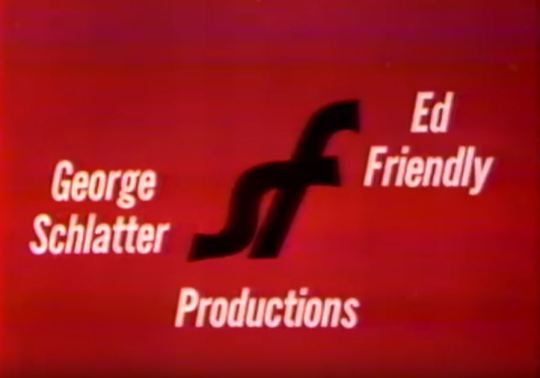
This
Date in Lucy History – April
13

Leave a comment